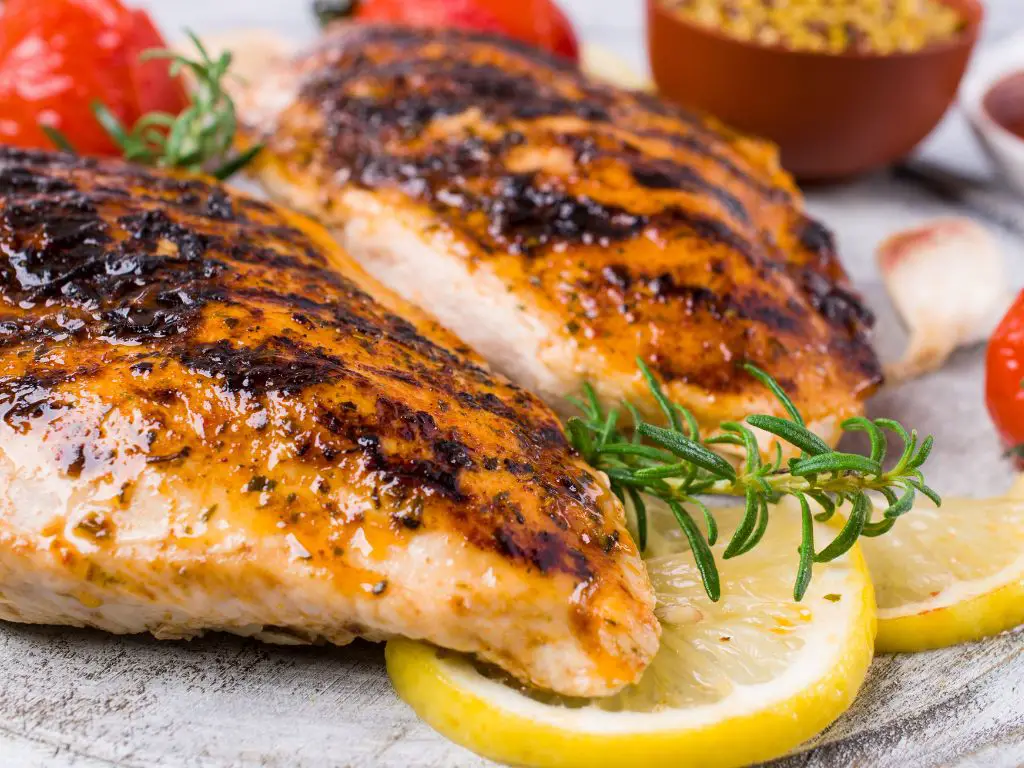Sous vide cooking involves cooking vacuum-sealed foods in precise, temperature-controlled water baths. This cooking method allows for exact temperature control and extended cooking times to pasteurize foods. Chicken cooked sous vide emerges tender, moist, and safe when cooked correctly. However, proper storage after sous vide cooking is critical for maintaining quality and safety. This guide covers best practices for storing sous vide chicken.

Sous Vide Products I Use Every Day
As an Amazon affiliate, I earn from qualifying purchases.
Last update on 2025-03-03 / Affiliate links / Images from Amazon Product Advertising API
Quick Chilling After Cooking
Once the sous vide chicken reaches the target safe internal temperature, it’s important to chill it down quickly to prevent bacterial growth.
The safe minimum internal temperature for chicken is 165°F (74°C). However, with the extended cooking times of sous vide, chicken can be safely pasteurized at much lower temperatures as long as they are held for sufficient time. For example, cooking chicken to an internal temp of 144°F (62°C) for over 2.5 hours achieves a 7-log reduction in Salmonella bacteria, equivalent to instantaneous pasteurization at 165°F.
After cooking, the chicken should be removed from the sous vide bags and placed in an ice water bath to quickly drop the temperature. The goal is to get the chicken below 40°F (4°C) within 2 hours. This rapid chilling helps prevent the growth of pathogenic bacteria like Salmonella.
Vacuum sealing the chilled chicken or storing it in air-tight containers will help retain moisture and keep contaminants out.
Storing Sous Vide Chicken in the Refrigerator
Proper Containers
Refrigerating leftover sous vide chicken is a great way to enjoy it for meals over the next few days. Use proper containers to maximize freshness and prevent contamination.
The best options for refrigerating sous vide chicken include:
- Vacuum sealing pouches – Re-seal the cooked chicken in a new pouch with fresh water to preserve texture and prevent freezer burn.
- Zip-top bags – Transfer the chilled chicken to zip-top freezer bags, removing as much air as possible before sealing. This protects against contamination and keeps the chicken submerged.
- Airtight food containers – Glass, plastic or stainless steel containers with tight-fitting lids work well. Ensure the chicken is fully submerged in the liquid.
Do not use permeable containers like cardboard or Styrofoam, as they can harbor bacteria.
Shelf Life and Safety
Under proper refrigeration at 40°F (4°C) or below, properly prepped and stored sous vide chicken can safely last 3-4 days.
Monitor the chicken for any signs of spoilage:
- Unpleasant sour or ammonia odor
- Slime formation
- Discoloration or mushy texture
Discard any chicken exhibiting these warning signs of spoilage, as it may contain harmful bacteria.
When reheating refrigerated sous vide chicken, cook to 165°F internally to ensure safety.
Storing Sous Vide Chicken in the Freezer
Freezing is ideal for preserving sous vide chicken for longer term storage up to 3 months.
Freezing Techniques
To freeze sous vide chicken:
- Chill it rapidly after cooking as described above.
- Portion into airtight bags or containers leaving 1⁄2 inch headspace to allow for expansion.
- Remove as much air as possible before sealing bags. Use a vacuum sealer if possible.
- Label bags with contents and freeze-by date.
- Freeze at 0°F or below for best quality and safety.
Hard freezing in thin layers helps prevent large ice crystals from forming and damaging the chicken’s texture.
Thawing and Reheating
To thaw frozen sous vide chicken:
- For best safety, thaw in the refrigerator overnight.
- To thaw quickly, place sealed bags under cold running water or in an ice bath.
- Cook frozen chicken straight from freezer by adding 50% more time to the sous vide recipe. The chicken will thaw as it heats.
Always cook thawed chicken back up to 165°F minimum internal temperature before serving. Check temperature with an instant-read thermometer.
Preventing Cross-Contamination
To avoid cross-contamination when working with raw and cooked chicken:
- Maintain meticulous sanitation and avoid direct contact between raw and cooked chicken.
- Use separate cutting boards, knives, tools and storage containers for raw and cooked chicken. Wash thoroughly.
- Bag cooked chicken in clean vacuum pouches or airtight containers separate from raw chicken.
- Label bags clearly as “raw” or “cooked” as needed.
- Wash hands thoroughly with soap before and after handling chicken.
Following sound sanitation principles is key to preventing illness.
Labeling and Tracking Stored Sous Vide Chicken
Proper labeling ensures sous vide chicken items are clearly identifiable and rotation practices are followed. Include these details:
- Contents (type of chicken cut)
-Cooking date
- Final pasteurization temperature and time
- Use-by or freeze-by date
Organize stored chicken by age, using oldest first. Track inventory and follow expiration dates.
Conclusion: Enjoying Safe and Delicious Sous Vide Chicken
With proper rapid chilling, storage methods, temperature control and sanitation practices, sous vide chicken can be safely preserved for meals throughout the week. Vacuum sealing, freezing, and refrigeration allow the chicken’s quality textures and moisture to be retained. By following sound food safety principles, home chefs can fully enjoy the advantages of sous vide chicken.


![IMPRESA [10 Pack] Sous Vide Magnet Weights for Keeping Bags Submerged – Sous Vide Accessories to Stop Floating Bags & Undercooking – Weighted Magnets for Containers](https://m.media-amazon.com/images/I/41zHpl8G2lL._SL160_.jpg)

